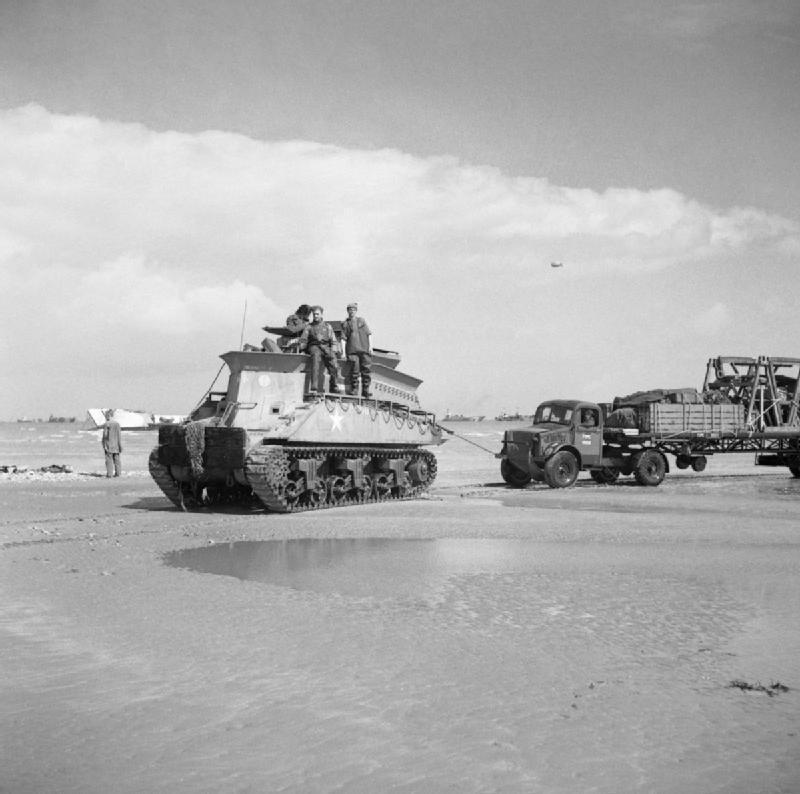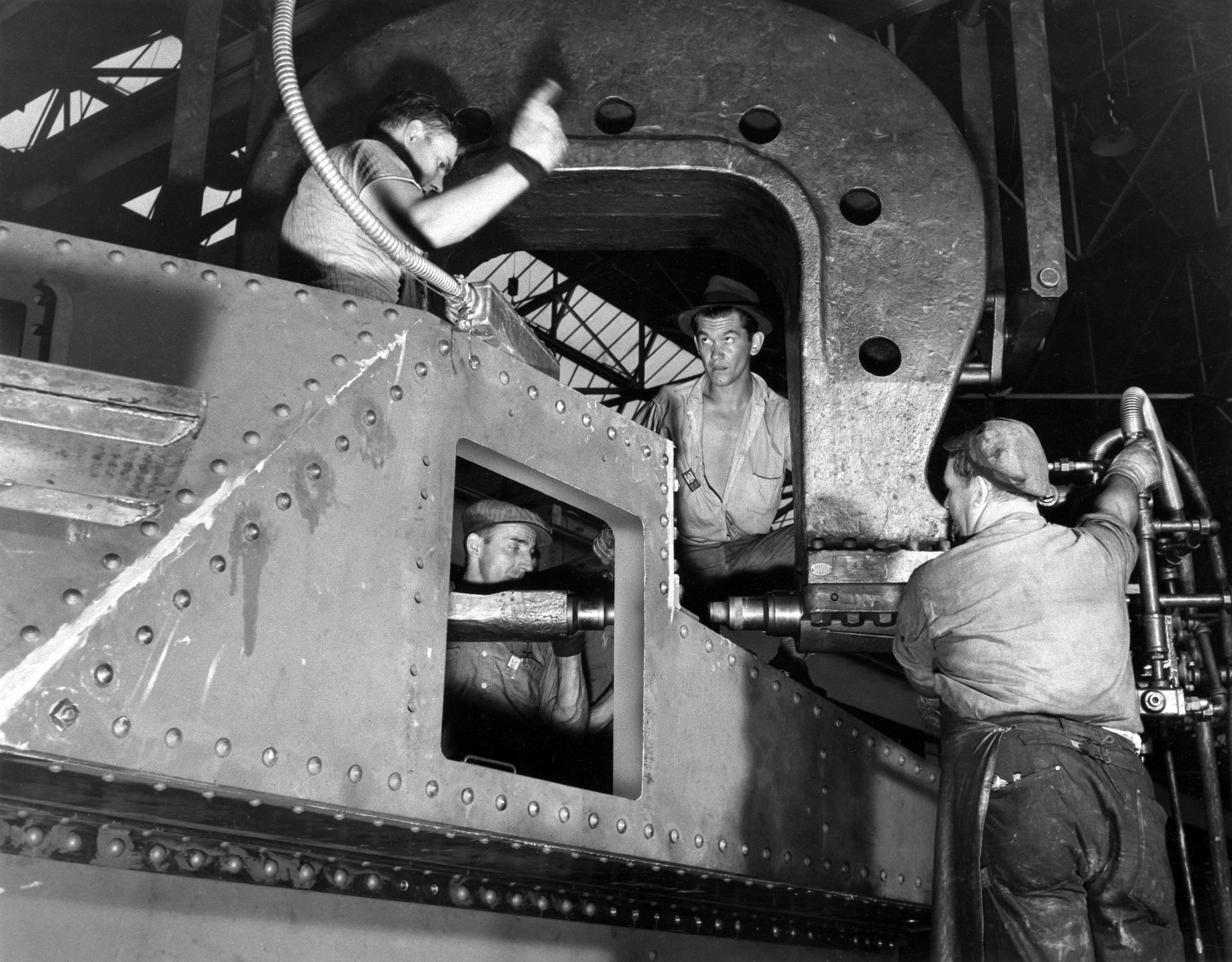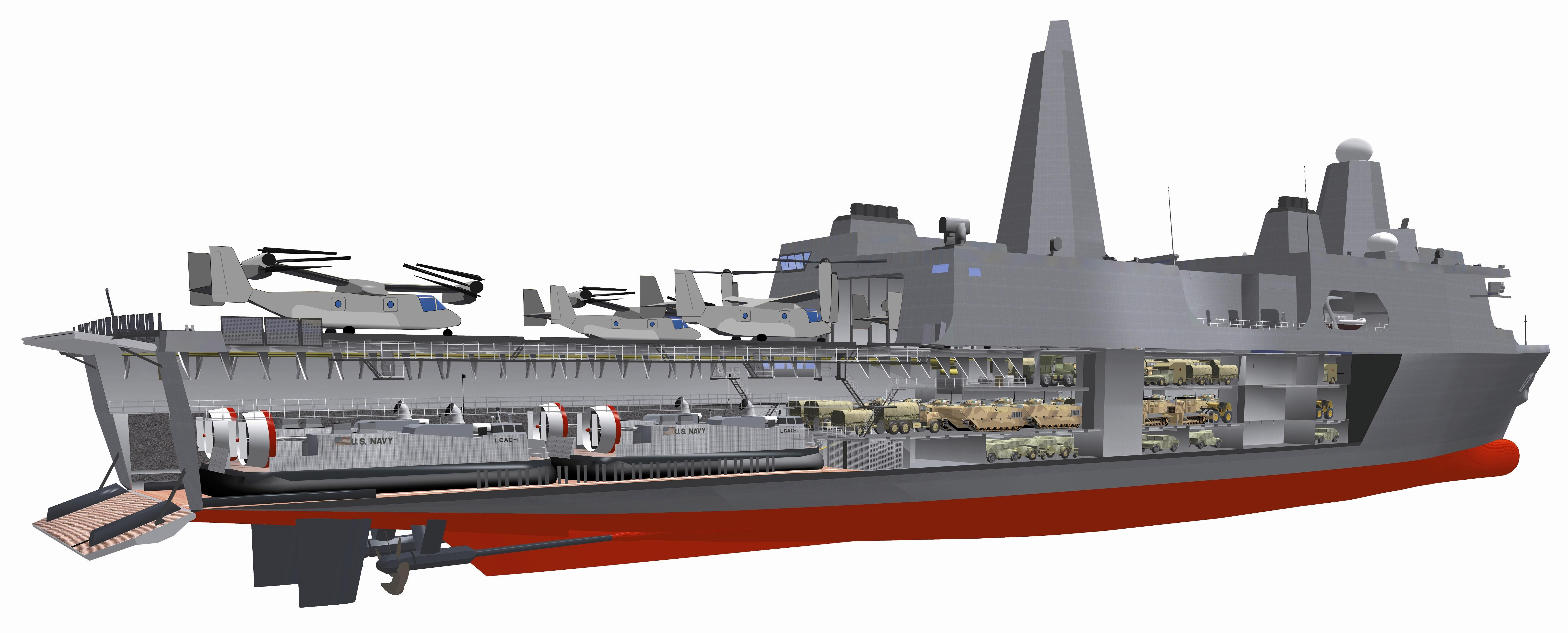|
BARV
A beach armoured recovery vehicle (BARV) is an armoured recovery vehicle used for amphibious landings. There have been three different BARVs in British service since their introduction during World War II. They have also been used by Dutch and Australian forces. Sherman BARV The original BARV was a Sherman M4A2 tank which had been waterproofed and had the turret replaced by a tall armoured superstructure. Around 60 were deployed on the invasion beaches during the Battle of Normandy. Able to operate in 9-foot (2.7 metre) deep water, the BARV was used to remove vehicles that had become broken-down or swamped in the surf and were blocking access to the beaches. They were also used to re-float small landing craft that had become stuck on the beach. Unusually for a tank, the crew included a diver whose job was to attach towing chains to stuck vehicles. The vehicles were developed and operated by the Royal Electrical and Mechanical Engineers. The Sherman M4A2 model was chosen as a ... [...More Info...] [...Related Items...] OR: [Wikipedia] [Google] [Baidu] |
Sherman BARV
A beach armoured recovery vehicle (BARV) is an armoured recovery vehicle used for amphibious landings. There have been three different BARVs in British service since their introduction during World War II. They have also been used by Dutch and Australian forces. Sherman BARV The original BARV was a Sherman M4A2 tank which had been waterproofed and had the turret replaced by a tall armoured superstructure. Around 60 were deployed on the invasion beaches during the Battle of Normandy. Able to operate in 9-foot (2.7 metre) deep water, the BARV was used to remove vehicles that had become broken-down or swamped in the surf and were blocking access to the beaches. They were also used to re-float small landing craft that had become stuck on the beach. Unusually for a tank, the crew included a diver whose job was to attach towing chains to stuck vehicles. The vehicles were developed and operated by the Royal Electrical and Mechanical Engineers. The Sherman M4A2 model was chosen as a ... [...More Info...] [...Related Items...] OR: [Wikipedia] [Google] [Baidu] |
Armoured Recovery Vehicle
An armoured recovery vehicle (ARV) is typically a powerful tank or armoured personnel carrier (APC) chassis modified for use during combat for military vehicle recovery (towing) or repair of battle-damaged, stuck, and/or inoperable armoured fighting vehicles, such as tanks and armoured personnel carriers. Most ARVs have motorized tracks, like a tank or bulldozer, enabling the ARV to operate on uneven ground. The term "Armoured Repair and Recovery Vehicle" (ARRV) is also used. ARVs may have winches, jibs, cranes, and/or bulldozer blades to aid in tank recovery. Typically, any specialized lifting and recovery equipment replaces the turret and cannon found on a battle tank. ARVs may in some cases have electric generators, blowtorches, chainsaws and fuel pumps to help with recovery operations, or spare parts, to facilitate field repairs. Some ARVs have a spade component to anchor the vehicle when it is towing or lifting. Since most ARVs are based on tank or APC chassis, they have ... [...More Info...] [...Related Items...] OR: [Wikipedia] [Google] [Baidu] |
Centurion (tank)
The Centurion was the primary British Army main battle tank of the post-World War II period. Introduced in 1945, it is widely considered to be one of the most successful post-war tank designs, remaining in production into the 1960s, and seeing combat into the 1980s. The chassis was adapted for several other roles, and these variants have remained in service. It was a very popular tank with good armour, manoeuvrability, and armament. Development of the Centurion began in 1943 with manufacture beginning in January 1945. Six prototypes arrived in Belgium less than a month after the war in Europe ended in May 1945. It entered combat with the British Army in the Korean War in 1950 in support of the UN forces. The Centurion later served on the Indian side in the Indo-Pakistani War of 1965, where it fought against US-supplied M47 and M48 Patton tanks, and it served with the Royal Australian Armoured Corps in the Vietnam War. Israel's army used Centurions in the 1967 Six-Day War, t ... [...More Info...] [...Related Items...] OR: [Wikipedia] [Google] [Baidu] |
Centurion Tank
The Centurion was the primary British Army main battle tank of the post-World War II period. Introduced in 1945, it is widely considered to be one of the most successful post-war tank designs, remaining in production into the 1960s, and seeing combat into the 1980s. The chassis was adapted for several other roles, and these variants have remained in service. It was a very popular tank with good armour, manoeuvrability, and armament. Development of the Centurion began in 1943 with manufacture beginning in January 1945. Six prototypes arrived in Belgium less than a month after the war in Europe ended in May 1945. It entered combat with the British Army in the Korean War in 1950 in support of the UN forces. The Centurion later served on the Indian side in the Indo-Pakistani War of 1965, where it fought against US-supplied M47 and M48 Patton tanks, and it served with the Royal Australian Armoured Corps in the Vietnam War. Israel's army used Centurions in the 1967 Six-Day War, th ... [...More Info...] [...Related Items...] OR: [Wikipedia] [Google] [Baidu] |
Yad La-Shiryon
Yad La-Shiryon (officially: The Armored Corps Memorial Site and Museum at Latrun; he, יד לשריון) is Israel's official memorial site for fallen soldiers from the Israeli Armor Corps, armored corps, as well as one of the most diverse tank museums in the world. The cornerstone for Yad La-Shiryon was laid on . The site was created through the initiative of veteran officers of the armored corps. The outdoor display includes 110 tanks and other armored fighting vehicles, both Israeli and captured enemy examples including the Merkava and T-34, T-54, T-55, T-62 tanks, as well as vehicles obtained or purchased from allied nations specifically for diversifying the collection like the German Leopard tank or the only T-72 on display in Israel. Other notable items include: an M4 Sherman tank mounted high atop a former British water tower; a collection of mobile bridges constructed by the IDF (Israeli Defense Forces) which can be carried by tanks and erected while under fire; captured ... [...More Info...] [...Related Items...] OR: [Wikipedia] [Google] [Baidu] |
M3 Lee
The M3 Lee, officially Medium Tank, M3, was an American medium tank used during World War II. The turret was produced in two forms, one for US needs and one modified to British requirements to place the radio next to the commander. In British Commonwealth service, the tank was called by two names: tanks employing US pattern turrets were called "Lee," named after Confederate general Robert E. Lee, while those with British pattern turrets were known as "Grant," named after Union general Ulysses S. Grant. Design commenced in July 1940, and the first M3s were operational in late 1941. The US Army needed a medium tank armed with a 75mm gun and, coupled with the United Kingdom's immediate demand for 3,650 medium tanks, the Lee began production by late 1940. The design was a compromise meant to produce a tank as soon as possible. The M3 had considerable firepower and good armor, but had serious drawbacks in its general design and shape, including a high silhouette, an archaic sponson ... [...More Info...] [...Related Items...] OR: [Wikipedia] [Google] [Baidu] |
Royal Marines
The Corps of Royal Marines (RM), also known as the Royal Marines Commandos, are the UK's special operations capable commando force, amphibious light infantry and also one of the five fighting arms of the Royal Navy. The Corps of Royal Marines can trace their origins back to the formation of the "Duke of York and Albany's maritime regiment of Foot" on 28 October 1664, and can trace their commando origins to the formation of the 3rd Special Service Brigade, now known as 3 Commando Brigade on 14 February 1942, during the Second World War. As a specialised and adaptable light infantry and commando force, Royal Marine Commandos are trained for rapid deployment worldwide and capable of dealing with a wide range of threats. The Corps of Royal Marines is organised into 3 Commando Brigade and a number of separate units, including 47 Commando (Raiding Group) Royal Marines, and a company-strength commitment to the Special Forces Support Group. The Corps operates in all environments ... [...More Info...] [...Related Items...] OR: [Wikipedia] [Google] [Baidu] |
HMS Fearless (L10)
HMS ''Fearless'' (L10) was a Royal Navy amphibious assault ship that served from 1965 until 2002. One of two s, she was based in HMNB ''Portsmouth'' and saw service around the world over her 37-year life. She was the last steam-powered surface ship in the Royal Navy. Role The landing platform docks (LPD) supported a Royal Marines amphibious assault force and provided a platform for the Headquarters capability prior to, and during, the assault phase. The Royal Marines served aboard as the 4th Assault Squadron. The Squadron included crew for the four LCUs, four LCVPs and the Beach Party, which was equipped with a Land Rover, a Bedford 4-ton truck, two tractor units—one a track layer, the other equipped with a bucket—and a Centurion BARV. The squadron also had duties aboard, (ensuring equipment and troops got to shore as they were needed), radio operators and administration. Service ''Fearless'' was the first purpose-built LPD used by the Royal Navy. Built in Belfast at ... [...More Info...] [...Related Items...] OR: [Wikipedia] [Google] [Baidu] |
HMS Intrepid (L11)
HMS ''Intrepid'' (L11) was one of two amphibious warfare ships of the Royal Navy. A landing platform dock (LPD), she served from 1967 until 1999. Based in HM Naval Base, Devonport, Plymouth, Devon and HM Naval Base Portsmouth, she saw service around the world over her 32-year life. At one point slated for decommissioning under terms of the 1981 Defence White Paper, she was rapidly returned to service to sail as part of the British operation to retake the Falkland Islands after the Argentine invasion in 1982. She landed troops in amphibious assaults on the Islands and the Argentine surrender was signed on her deck at the conclusion of the Falklands War. Role The landing platform docks (LPDs) provided support to a Royal Marines amphibious assault force and provided a platform for the Headquarters capability prior to, and during, the assault phase. Service ''Intrepid'' was the second of her class of purpose built LPDs used by Royal Navy. She was built in Clydebank, West Dun ... [...More Info...] [...Related Items...] OR: [Wikipedia] [Google] [Baidu] |
British Army
The British Army is the principal land warfare force of the United Kingdom, a part of the British Armed Forces along with the Royal Navy and the Royal Air Force. , the British Army comprises 79,380 regular full-time personnel, 4,090 Gurkhas, and 28,330 volunteer reserve personnel. The modern British Army traces back to 1707, with antecedents in the English Army and Scots Army that were created during the Restoration in 1660. The term ''British Army'' was adopted in 1707 after the Acts of Union between England and Scotland. Members of the British Army swear allegiance to the monarch as their commander-in-chief, but the Bill of Rights of 1689 and Claim of Right Act 1689 require parliamentary consent for the Crown to maintain a peacetime standing army. Therefore, Parliament approves the army by passing an Armed Forces Act at least once every five years. The army is administered by the Ministry of Defence and commanded by the Chief of the General Staff. The Brit ... [...More Info...] [...Related Items...] OR: [Wikipedia] [Google] [Baidu] |
Bovington Camp
Bovington Camp () is a British Army military base in Dorset, England. Together with Lulworth Camp it forms part of Bovington Garrison. The garrison is home to The Armour Centre and contains two barracks complexes and two forest and heathland training areas that support Phase Two training for soldiers of the Royal Armoured Corps and trade training for the Household Cavalry Regiment as well as other armoured units. It also houses The Tank Museum on its property. It is run by the resident RSM W01 Joshua Wisdom History The camps at Bovington and Lulworth were originally established in 1899 as an infantry training area and ranges. In 1916, they became training camps for the Heavy Branch of the Machine Gun Corps which relocated from Norfolk. The Heavy Branch was responsible for the operation of the tank in the British Army. In 1917 the Heavy Branch split from the Machine Gun Corps to become the Tank Corps, with the Depot and Central Schools being based at Bovington. In 1937 the Cen ... [...More Info...] [...Related Items...] OR: [Wikipedia] [Google] [Baidu] |
Landing Platform Dock
An amphibious transport dock, also called a landing platform dock (LPD), is an amphibious warfare ship, a warship that embarks, transports, and lands elements of a landing force for expeditionary warfare missions. Several navies currently operate this kind of ship. The ships are generally designed to transport troops into a war zone by sea, primarily using landing craft, although invariably they also have the capability to operate transport helicopters. Amphibious transport docks perform the mission of amphibious transports, amphibious cargo ships, and the older dock landing ships (LSD) by incorporating both a flight deck and a well deck that can be ballasted and deballasted to support landing craft or amphibious vehicles. The main difference between LSDs and LPDs is that while both have helicopter landing decks, the LPD also has hangar facilities for protection and maintenance. In the United States Navy, the newer class of LPD has succeeded the older classes of LSDs, and bot ... [...More Info...] [...Related Items...] OR: [Wikipedia] [Google] [Baidu] |



.jpg)



